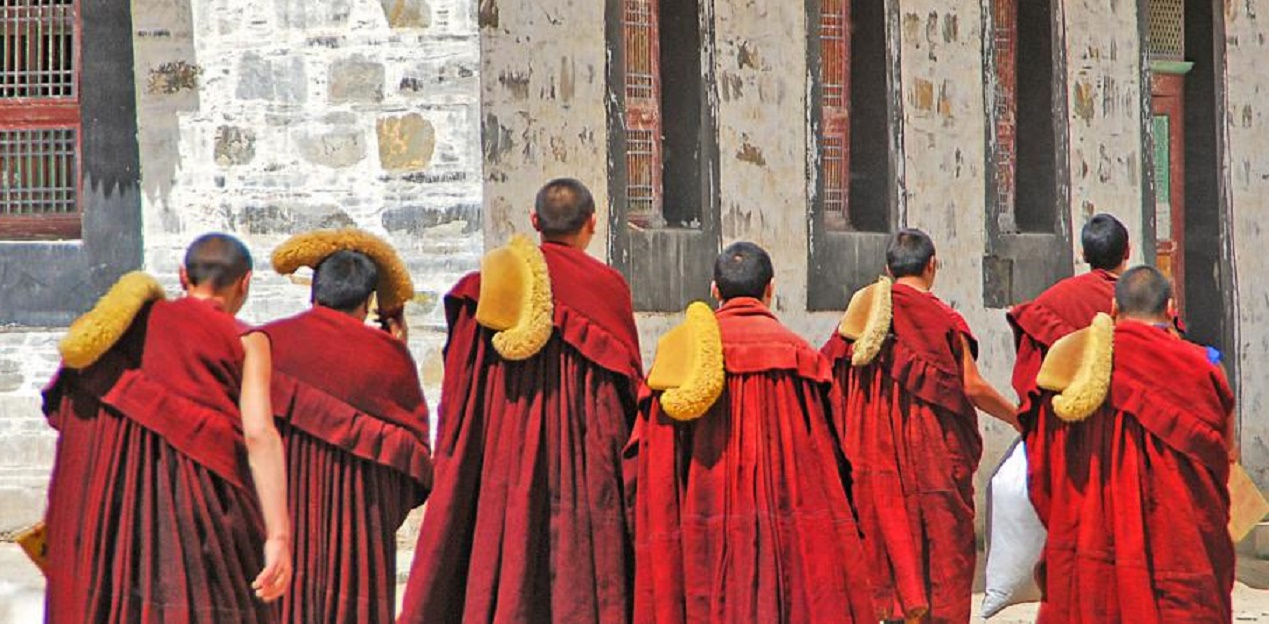Four years after passing a similar law in Xinjiang, the Chinese government passed the “Regulations on the Establishment of a Model Area for Ethnic Unity and Progress” in Tibet earlier this year. This contentious new law identifies Tibet “an inalienable part of China since ancient times” and calls upon ethnic minorities “to safeguard national reunification and take a clear stand against separatism.”1 This law to strengthen “ethnic unity” has been largely interpreted as a novel tool to accelerate Tibetans’ assimilation with the Han Chinese population, thereby advancing “complete Sinicization” in the region.2 The interpretation is not unfounded given that since its occupation of Tibet in 1959, the Chinese government has undertaken several initiatives that have undermined the Tibetan religion, language, and culture. Some of these initiatives are discussed in this article.
The rampant demolition drive including the destruction of Larung Gar (world’s biggest Tibetan Buddhist Institute) and Yarchen Gar monasteries are recent examples of state led attempts to exterminate Tibetan religion and heritage. In addition to the dismissal of nuns and monks from these and several other monasteries ‘re-education’ sessions are often imposed on the religious practitioners. They are also said to be forced to wear “military clothing and undergo political indoctrination in detention centres”.3 These measures are aimed at obstructing the monastic system which has traditionally served as educational institution for Buddhist teachings in the Tibetan society.4 Various monasteries played a role in organising classes on writing Tibetan language for ordinary people while monks also imparted lessons to people while traveling.5 The recent clampdown on monasteries and restrictions on movement of these religious practitioners has restricted ordinary population from learning the Tibetan script.
Furthermore, several restrictions have been imposed on the Tibetan population in general from either practising or participating in their indigenous religious rituals. Regulations discouraging ‘religiosity’ among government employees and university students such as visiting temples and monasteries, participating in prayer assemblies and other events for common devotees, including making religious donations have already been in place for some time.6 Now, under new regulations even the retired elderly Tibetans are prohibited from performing the kora (a Tibetan Buddhist practice of circumambulating a sacred site o while reciting prayers or mantras) other such religious practices. Punitive measures including the cancellation of pensions, health cards and other post retirement facilities are used to this end by state authorities.7
The most radical attack that the Chinese Communist Party (CCP) has levelled against the religion in Tibet is against the followers’ reverence to the exiled Dalai Lama-a principal tenet of their religious belief. State campaign to denounce the Dalai Lama as well as his “vilification” by the state- and state-owned media is “one of the most offensive aspects of the government’s religious policy”.8
China’s education policy is another state led tool to accelerate the assimilation process in Tibet by drastically reducing the access of ethnic Tibetans to education in their mother tongue. China formally introduced a policy of “bilingual education” in 2010 for schools in all minority areas in China including the TAR. In practice, however, there has been a systematic replacement of Tibetan language by Chinese as the primary medium of instruction with Tibetan being taught only in classes where the Tibetan language is the topic of the class. Ethnic Chinese teachers with little or no knowledge of the Tibetan language are hired in schools to promote Chinese-medium of instruction at the expense of Tibetan.9 This policy has not only hampered the knowledge of Tibetan among Tibetan school goers but has also resulted in layoffs of Tibetan teachers who previously taught in these schools. Furthermore, new Chinese-language textbooks carry little or no material on Tibetan history and culture and propagate defamatory material against the Dalai Lama as well.10 Moreover, Tibetan children are barred from either joining monasteries or receiving religious education until the age of 18.11 This is a crucial development given that formative years play an important role in the learning and appreciation one’s heritage and culture.
Official affairs too are conducted primarily in Chinese. This leaves little room for choice as one is forced to prioritise Chinese over Tibetan in order to enter university as well as to ensure employment prospects later on. Owing to such repressive laws exercised by the state, Tibetans are basically rendered helpless and “cannot practice their religion freely, nor can they protect their culture and language in a meaningful way.”12 Protests in this regard are usually suppressed by levelling charges of “inciting separatism” against them. Most notable case in this respect is a five-year sentence of a Tibetan language activist Tashi Wangchuk on 22 May 2018, two years after he was arrested on a similar charge in January 2016.13
Since China’s policy towards Tibet is driven by strategic and security concerns,14 Beijing has grossly overruled the identity and heritage issues in the region and has strived towards religious and cultural assimilation of Tibet with mainland China’s. These measures have not gone unchallenged and the Tibetans have continued their resistance against the repressive policies of the Chinese Communist Party (CCP) in the last seven decades. The expansion of campaigns forcing monastics and commoners to denounce their revered leader, the Dalai Lama has been particularly instrumental in triggering frequent protests. The 2008 anti-China demonstrations to mark the anniversary of the 1959 rebellion renewed international attention towards the suppressive policies of China in Tibet as it came on the heels of the Olympic Games for which China was the host that year. Several cases of self-immolations15, rebellious songs16 are well documented despite China’s attempts to prevent dissemination of information outside. Between 2009 and 2019, 156 cases of self-immolations have been reported within Tibet and neighbouring regions in China. International Campaign for Tibet (last updated on 2 December 2019). Many Tibetans also employ more subtle forms of resistance, creating avenues to discreetly engage in forbidden religious practices or share information.17 Meanwhile, the CCP continues with its heavy crackdown of protests and protestors. As the 2019 Report on International Religious Freedomby the US Department of State notes, “forced disappearances, arrests, torture, physical abuse, including sexual abuse and prolonged detentions without trial of individuals due to their religious practices continued in TAR and other Tibetan areas.”18
Destruction of monasteries and removal of religious practitioners, vilification of the Dalai Lama, language imposition in the garb of imparting the seemingly harmless bilingual education are aimed at assimilation and constitute clear violation of religious and cultural rights of the indigenous people.The Chinese education policy is clearly motivated by political imperatives rather than educational ones and strives towards limiting the knowledge of Tibetan among young generation. In doing so, the CCP has also violated its international legal obligations and commitment to provide Tibetan-language instruction to Tibetans. In addition, bypassing of a new regulation on ethnic unity in the backdrop of Covid-19, the CCP has leveraged the pandemic induced restrictions to exacerbate repression and cultural destruction in Tibet.
(This is a 2-part article. This part focuses on the religious and cultural repression in Tibet. Part 2 of this article would focus on forced resettlement of the population and the ensuing ecological impact in the region.)
Endnotes
- https://indianexpress.com/article/explained/explained-tibet-passes-law-to-make-ethic-unity-mandatory-what-it-means-6217452/
- https://tibet.net/chinas-ethnic-unity-bill-aimed-at-complete-sinicization-of-the-tibetan-plateau-through-ethnic-cleansing-cta-information-secretary/
- https://www.state.gov/reports/2019-report-on-international-religious-freedom/china/tibet/
- https://www.nytimes.com/2015/11/29/world/asia/china-tibet-language-education.html
- https://www.govinfo.gov/content/pkg/CHRG-115hhrg30232/html/CHRG-115hhrg30232.htm
- https://freedomhouse.org/report/2017/battle-china-spirit-tibetan-buddhism-religious-freedom
- https://www.hrw.org/sites/default/files/supporting_resources/1908_ccp_tar_notice.pdf
- https://freedomhouse.org/report/2017/battle-china-spirit-tibetan-buddhism-religious-freedom
- https://www.euractiv.com/section/trade-society/opinion/chinese-erosion-of-tibetan-identity-should-not-be-tolerated/
- https://www.hrw.org/report/2020/03/04/chinas-bilingual-education-policy-tibet/tibetan-medium-schooling-under-threat
- https://www.refworld.org/pdfid/519623a24.pdf
- https://savetibet.org/international-campaign-for-tibets-oral-statement-at-the-un-cerd-96th-session-in-geneva-on-august-7-2018/
- https://tibet.net/rule-by-law-chinas-new-ethnic-unity-regulation-in-tar/
- http://www.ipcs.org/issue_select.php?recNo=510
- Between 2009 and 2019, 156 cases of self-immolations have been reported within Tibet and neighbouring regions in China. International Campaign for Tibet, last updated on 2 December 2019, https://savetibet.org/tibetan-self-immolations/
- The nuns have played a crucial role in the resistance movement inside Tibet. To read more on their role refer to “Singing Nuns of Tibet: From Language of Buddhism to Language of Protest” by Tsering Kalden, available at https://tibetpolicy.net/tibet-policy-journal-vi-ii/
- https://freedomhouse.org/report/2017/battle-china-spirit-tibetan-buddhism-religious-freedom
- https://www.state.gov/reports/2019-report-on-international-religious-freedom/china/tibet/
(The paper is the author’s individual scholastic articulation. The author certifies that the article/paper is original in content, unpublished and it has not been submitted for publication/web upload elsewhere, and that the facts and figures quoted are duly referenced, as needed, and are believed to be correct). (The paper does not necessarily represent the organisational stance... More >>
Image Source: https://freedomhouse.org/sites/default/files/styles/1380x450_fp_and_crop_/public/2020-02/Religious_Freedom_HERO_shutterstock_1189551523-9.jpg?h=fe8828f5&itok=Xer6reat











Post new comment